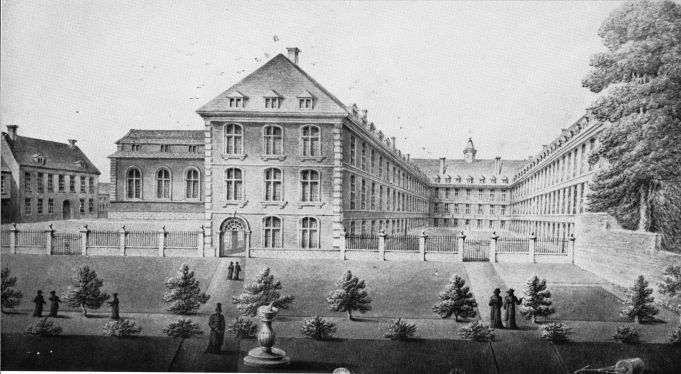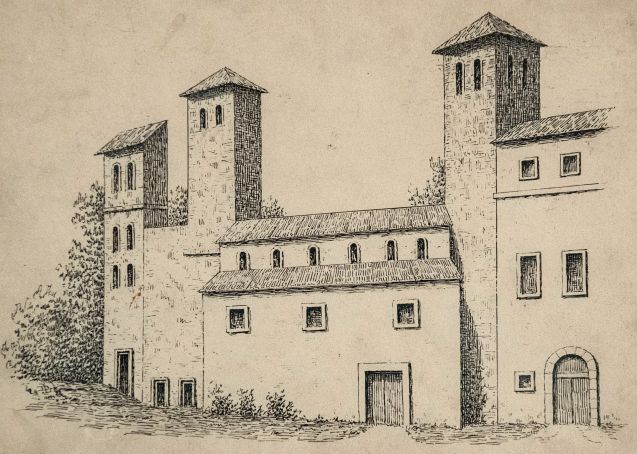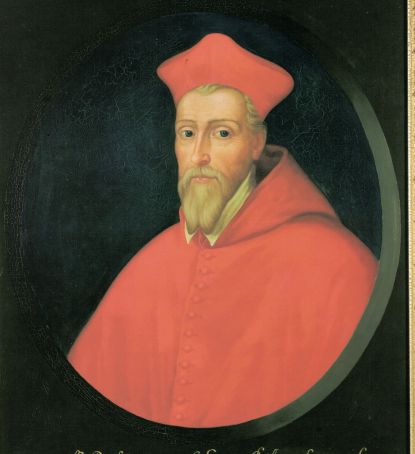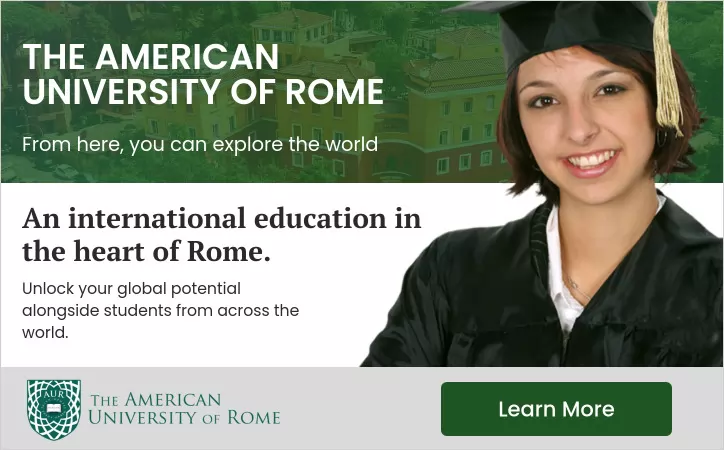Rome's Venerable English College celebrates three significant anniversaries.
A discreet brass nameplate on the inner entrance door at Via di Monserrato 45, a stone’s throw from the offices of Wanted in Rome in the heart of the centro storico, provides a very modest indication of an English and Welsh institution which has stood on that very site for over 650 years.
The Venerable English College (VEC), the oldest British institution outside Britain, is hosting a major exhibition to celebrate three significant anniversaries. Entitled Memory, Martyrs and Mission, the exhibition runs from 16 April to 11 May, under the patronage of the Pontifical Council for Culture. This stunning display of sacred treasures explores aspects of the history of the English Hospice and the Venerable English College and the interactions of these two institutions with both Roman and wider Italian society and with England and Wales since 1362.
Hospice for pilgrims
The age-old buildings of the English Hospice, part of the present-day college complex (including the Wanted in Rome offices), stood on the ancient pilgrim route from S. Giovanni in Laterano to St Peter’s Basilica. Beginning life in 1362, this hospice for pilgrims from England and Wales soon acquired its own church dedicated to that most English of saints, Thomas Becket (c.1118–1170), former chancellor of England and archbishop of Canterbury. Murdered in his own cathedral at Canterbury in 1170 and canonised at Segni (south-east of the Castelli) just three years later, St Thomas of Canterbury quickly became a popular saint in mediaeval Europe: his shrine at Canterbury, then second only to Santiago de Compostela as a place of pilgrimage, was suppressed by Henry VIII in 1538 following the king’s break with Rome, though today the feast of St Thomas of Canterbury on 29 December is still observed throughout the Anglican Communion.
Penal laws
During the reign of Elizabeth I, from 1558 to 1603, life for Catholics in England and Wales became increasingly perilous. New penal laws passed by parliament at Westminster aimed to suppress the “old religion” and, by 1603, more than 180 Catholic subjects of Elizabeth had been put to death for their religious beliefs.

When, in 1568, an English College was founded at the university of Douai in the Spanish Netherlands, now modern-day France, to educate and train Catholic priests to serve on the new, clandestine post-Reformation Catholic mission to England and Wales, the new institution proved highly successful.
Immense dangers
Despite the immense dangers involved, so many young men from England and Wales came forward to train as future priests that the English College at Douai soon reached capacity. By 1576, students unable to secure a place there began crossing the Alps to seek their education at the new Collegio Romano, founded by Ignatius Loyola in 1551 and today known as the Gregorian University. Needing accommodation in Rome, they sought board and lodgings at the existing English Hospice.
Venerable status
By 1579, the hospice was so full of students, rather than pilgrims, that William Allen (1532–1594), the former principal of St Mary Hall, Oxford, who had founded the English College at Douai, successfully petitioned Pope Gregory XIII to convert the hospice into a modern seminary for England and Wales: surprisingly, perhaps, the new English College was given the title “Venerable” at the time of its foundation.
From at least the eighth century there had been a Saxon settlement (or “schola Saxonum”) in the Borgo, close to St Peter’s Basilica, on or near the site of the Ospedale dello Spirito S. in Sassia – so named because of the Saxon settlement. Though the importance of this settlement had diminished following the Norman conquest of England in 1066, and even though the ancient Saxon settlement and the new English College of 1579 had no formal connection, the title “Venerable” reflected the antiquity of the links between early English Christianity and the see of Rome.
Martyrs
Between 1581 and 1679, 44 former members of the Venerable English College (VEC) were executed in England or Wales for their religious beliefs. Ten of these are canonised, including St Ralph Sherwin (1550–1581), the first of the College’s martyrs, and the great Elizabethan poet, St Robert Southwell SJ (c. 1561–1595).
Though, constitutionally, the VEC was never a Jesuit institution, it was placed under Jesuit administration from 1579 until the suppression of the Society of Jesus in 1773. It then passed into the administration of Italian secular clergy until the College was sequestrated by the French following the occupation of Rome in 1798.

Closed for a period of 20 years, the VEC reopened in 1818 under the administration of the secular clergy of England and Wales. Apart from an interruption during world war two, when the staff and students moved temporarily to England for greater safety, the College has continued operating on Via di Monserrato for the past 200 years.
The forthcoming exhibition will mark three significant anniversaries – the 900th anniversary of the birth of St Thomas of Canterbury circa 1118, the 450th anniversary of the founding of the English College at Douai in 1568, and the bicentenary of the re-opening of the VEC in 1818.
Sacred treasures
To illustrate aspects of this long history, the exhibition will include a spectacular selection of sacred treasures and precious documents from three institutions – the Venerable English College itself, Stonyhurst College in Lancashire, and the English College at Douai (which moved to England in 1794, dividing into two new communities: Ushaw College, Durham, and St Edmund’s College, Ware, in Hertfordshire).
A number of the artefacts today preserved at Stonyhurst came originally from the VEC: these were salvaged at the time of the suppression of the Jesuits in 1773 by the English Jesuit antiquarian, John Thorpe (1726–1792), who spent most of his life in Rome. Prior to his death, Thorpe bequeathed these precious objects to the English Academy at Liège. When that institution was forced to flee the French Revolution in 1794, it moved to Stonyhurst, where the treasures have been preserved ever since. Many of these will be returning to Rome for the first time since 1773.
Memory, Martyrs and Mission
Organized in 18 sections, the exhibition explores the three themes of Memory, Martyrs and Mission. These focus on key periods in the history of the Hospice and College; the life and work of the martyrs associated with the two institutions; and the lives and work of those who have served the mission in England and Wales since 1579.
Among the treasures on display is a 14th-century manuscript life of St Thomas of Canterbury, alongside a fragment of one of the hair shirts which the saint is famously known to have worn, preserved for centuries afterwards at the English College at Douai.

The Douai-Rome connection is explored through a number of treasures, including copies of the Douai New Testament of 1582 and the famous Douai-Rheims edition of The Holie Bible, published in 1609–10: this early Catholic translation of the Bible into English pre-dated the King James Version of 1611.
Perhaps the most unusual exhibit is a small silver casket containing the eye of Blessed Edward Oldcorne SJ (1561–1606). A medical student who came to the VEC to study for the priesthood, Oldcorne was afterwards sent to serve on the English mission. At his execution at Worcester in 1606, the effect of his decapitation was so extreme that one of his eyes flew out of its socket, only to be preserved by a Catholic bystander as an extraordinary relic of martyrdom.
The exhibition is not only about the past: the present-day Venerable English College is a thriving institution and some of its 38 students have prepared, as the final section of the display, a series of visual images outlining the range and scope of the life and work of the College today.
By Maurice Whitehead
This article was first published in the April 2018 edition of Wanted in Rome
The exhibition, Memory, Martyrs and Mission, is being held at the Venerable English College, Via di Monserrato 45, tel. 066868546. It is open from 16 April-11 May, Mon-Fri 10.00-16.00. Entrance is free and visitors are most welcome.
Maurice Whitehead is the current Schwarzenbach Research Fellow at the Venerable English College and a Research Fellow at the British School at Rome.
General Info
View on Map
Memory, Martyrs and Mission
Via di Monserrato, 45, 00186 Roma RM, Italy

















